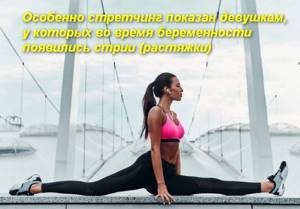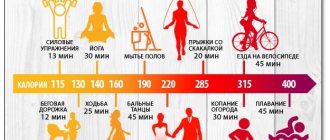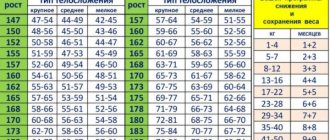How many calories do we actually burn during exercise?
The number of calories we burn during physical activity depends on a variety of factors, so what we do on a treadmill is something like the average temperature in a hospital.
Today we will look at what factors other than weight, height, gender and age affect the number of calories we burn, how to speed up this process, and also look at tables with the average calories burned during functional training, yoga or weight lifting . The computer on your treadmill, elliptical, or stepper only requires you to enter your age, height, and weight, and then gives you the arithmetic average. Understanding how many calories you actually burn requires a lot more information.
The simulator is not able to measure your body temperature, and also does not take into account the surrounding climatic conditions, that is, air temperature, humidity and the presence or absence of precipitation.
The number of calories you burn is affected by your muscle mass, body fat percentage, fitness level, metabolic rate, body temperature, ambient temperature, relative humidity, presence or absence of precipitation, barometric pressure, altitude, while running - your windage and wind direction, sleep patterns and even your diet.
For example, T is temperature, B is humidity. The combination of high T and high B is very difficult; high T and low B - it’s already easier; high B and low T - normal conditions; low T and high B - very cold; low T and low B - heat transfer is above average.
Breath
With increased physical activity, the heart rate increases, breathing becomes intermittent and frequent. This happens because the heart is trying to pump as much oxygen as possible so that the muscles can produce ATP (adenosine triphosphate). It is what fuels our body during exercise.
ATP was discovered in 1929 by a group of scientists at Harvard Medical School - Karl Lohman, Cyrus Fiske and Yellapragada Subbarao, and in 1941 Fritz Lipman showed that ATP is the main carrier of energy in the cell.
The main role of ATP in the body is associated with providing energy for numerous biochemical reactions. As the carrier of two high-energy bonds, ATP serves as a direct source of energy for many energy-consuming biochemical and physiological processes. All these are reactions of the synthesis of complex substances in the body: the implementation of active transfer of molecules through biological membranes, including the creation of a transmembrane electrical potential; implementation of muscle contraction.
It turns out that during such intense training, for every liter of oxygen that you inhale, 5 kcal are burned. Thus, if you compare two people with approximately the same physical parameters who perform the same exercises, the one who breathes more quickly will burn more calories.
This also means that the less prepared you are, the harder the workout will be for you and the more rapid your heart rate and breathing will be. This means you will burn more calories than a more fit person. If you want to burn more calories, breathe more often!
Tables
There are special sports applications for running and cycling, which, together with additional gadgets (heart rate monitor and sports watch), more or less accurately calculate the number of calories burned during training. For example, Garmin watches like the Fenix 3 and Forerunner 920XT theoretically take ambient temperature into account, while the Strava app takes into account the weight of the bike.
But for other types of activities - yoga, Pilates, step aerobics, functional training, weight lifting, and so on - it is much more difficult to get at least average data. For this purpose, special tables are compiled that will give you only a general idea of the number of calories burned. But it's better than nothing. We offer you data for the main types of training.
- Aerobics - 5.2 kcal per hour per 1 kg of weight.
- Fast dancing - 7.4 kcal per hour per 1 kg of weight.
- Football - 4.4 kcal per hour per 1 kg of weight.
- Volleyball - 4.8 kcal per hour per 1 kg of weight.
- Jumping rope - 5.6 kcal per hour per 1 kg of weight.
- Exercises on an elliptical trainer - 7.4 kcal per hour per 1 kg of weight.
- Climbing stairs / step - 7.4 kcal per hour per 1 kg of weight.
- Stretching - 1.8 kcal per hour per 1 kg of weight.
- Weight training - 3.8 kcal per hour per 1 kg of weight.
- Ashtanga yoga - 6 kcal per hour per 1 kg of weight.
- Static yoga - 3.2 kcal per hour per 1 kg of weight.
- Exercise cycle - 4.4 kcal per hour per 1 kg of weight.
- Light step aerobics - 7.4 kcal per hour per 1 kg of weight.
- Intense step aerobics - 10.6 kcal per hour per 1 kg of weight.
- Exercise bike (medium load) - 7.4 kcal per hour per 1 kg of weight.
- Exercise bike (intensive exercise) - 11.1 kcal per hour per 1 kg of weight.
- Rowing machine - 7.4 kcal per hour per 1 kg of weight.
- Intensive weight lifting - 6 kcal per hour per 1 kg of weight.
Calculator for calculating calories burned during strength training.
Swimming is a different story, since the clock does not take into account the number of calories that the body spends on heating, because the water temperature is always lower than body temperature.
How many calories are burned during exercise?
Calories are the energy the body receives through nutrition. Excess calories are converted into fat mass, which makes the figure fat and shapeless. You can get rid of fat accumulations with the help of various physical activities, which can not only remove extra pounds, but make your figure slim and fit. What burns calories best?
without causing harm to the body, we will consider it step by step.
- Running or walking on a treadmill or stepper can remove about 300 - 400 calories in an hour of exercise. The exlator simulator, which simulates walking up stairs, has also proven itself well. But this type of exercise uses only the lower muscles of the body, while the upper ones remain indifferent, which means they are not trained.
- Cycling helps burn approximately 300-500 cal/hour, everything will depend on the intensity of pedaling. But for very overweight and unprepared people, this load may seem excessive and unbearable. In addition, this sport has a number of contraindications.
- Aerobics can remove up to 500 calories from the body in an hour. The rhythmic pace of classes helps you lose weight and transform your overall figure. But diseases of the back, joints, and diseases of the cardiovascular system are quite powerful arguments against this type of weight loss. In this case, water aerobics is recommended.
- Water aerobics is the same as aerobics, but in a pool. In an hour of exercise you can burn more than 600 calories, which is equivalent to fast skiing. The advantages of this type of exercise include the ease of performing exercises, which is ensured by a decrease in body weight in the water. With regular exercise, fat reserves are dynamically burned, the skin tightens and becomes elastic. It has practically no contraindications and is recommended even for pregnant women. The calorie consumption table proves the high effectiveness of water aerobics in the pool.
- Swimming is an ideal sport for losing weight. Since water creates greater resistance, weight loss occurs with greater intensity. So, in an hour of simply floundering in the water you can lose up to 300 calories, and practicing breaststroke or butterfly can save you from 700 calories. In addition, swimming increases endurance, tightens the skin and creates an anti-cellulite massage.
If your goal is to lose weight, then a table of calorie consumption during physical activity will help you clearly understand which sport you should give preference to. When choosing, you should take into account the individual characteristics of the body, contraindications and training loads. It is advisable to record your calorie consumption daily, which will allow you to create the ideal combination of physical activity and calorie foods. If the ratio is correct, then the extra pounds will begin to melt before your eyes.
Sources:
https://pohudenie-tut.ru/1862_rastyazhka-skol-ko-kaloriy-szhigaet/ https://stretching-guru.ru/articles/rastyazhka-luchshij-sposob-sdelat-telo-strojnym/ https://fitness- page.ru/stretching-skolko-kalorii-szhigaetsya-za-chas-skolko-kalorii.html
Stretching for weight loss
Stretching is included in many proprietary fitness methods that help you lose weight and become the owner of a beautiful, toned figure in a relatively short period of time. It is usually recommended to combine it with cardio and strength training. This brings maximum effect, improves the condition of the muscles, preparing them for the next workout.
As a rule, classes are preceded by elements of dynamic stretching and completed with static exercises. They allow you to quickly remove lactic acid accumulated during exercise from the muscles in order to eliminate their soreness and maintain performance in the future.
Why does stretching help you lose weight?
So is it really possible to lose weight with stretching or is it just another advertising ploy to attract visitors to fitness centers? Experts say that this is quite possible, but only under the condition of an integrated approach to the training process. In particular, combining stretching with other activities is beneficial for your figure, and there are reasons for this.
How many calories are burned in an hour of exercise?
Stretching itself is not considered an energy-intensive technique. So, no matter how hard you try, the number of calories burned when stretching is easily replenished by eating a couple of apples: 150-200 kcal are burned in 1 hour of training. This is provided that you devoted all 60 minutes exclusively to static stretching, ignoring other fitness techniques.
This is primarily due to the fact that stretching does not involve active muscle contractions. On the contrary, stretching exercises relax the muscles and relieve increased tone from them.
Stretching compared to other types of training
If we draw parallels between stretching and other types of training, the latter will reveal much greater energy consumption. In 60 minutes of cardio training you will lose 600-900 kcal, and in 60 minutes. bodybuilding – 400-800 kcal.
Such a wide range of indicators among different people when playing the same sport is associated with differences in:
- Gender;
- Body weight;
- Age;
- Initial level of physical fitness;
- The number and duration of rest breaks;
- Intensity, speed of classes.
Calorie loss during intense exercise
The largest amount of calories is lost during dynamic and ballistic stretching - about 300 kcal per hour. However, the latter is only allowed for experienced athletes who have sufficient muscle mass and are able to control their own body movements well. If an unprepared person starts with ballistic stretching, it will only cause him harm - the risk of damage to tendons and ligaments will increase significantly.
There are specific modifications of classic stretching. For example, the Power Stretch program, in addition to classical stretching, includes static power poses that strengthen muscles.
For those who want to lose weight faster, the following weekly training program is suitable: 2 days – strength training; 2 days - stretching, 4 hours of cardio training per week. By following this recipe, you can “tighten” your body, lose extra pounds, but at the same time not “swing” like a seasoned bodybuilder.
How many calories does stretching burn?
A rare representative of the fairer sex, when choosing a type of training, is not concerned about the question of how beneficial it will affect her figure.
Stretching is no exception - you can not only get your body into excellent physical shape, but also monitor how many calories are burned per hour of exercise. It’s better to start with a general understanding: what kind of training it is, who it’s suitable for, why it’s interesting, and what results you should expect. If you want not just to lose weight, but to activate your metabolism, get rid of cellulite and salt deposits, then stretching will be the best option. You can train with any body type, regardless of the amount of extra pounds and age. And this is a significant plus - not everyone will risk doing serious physical activity in the absence of the appropriate form.
Stretching does not belong to the category of intense training; you should not expect radical losses of energy from it. The energy expenditure barrier varies from 150 to 200 kilocalories per hour-long workout. Specific numbers are directly related to metabolism, starting body weight, and the degree of metabolic intensity. The easiest way to obtain such information is by using special fitness bracelets.
Stretching is a gentle workout with minimal energy consumption
Relaxing workouts, which include not only stretching, but also Pilates, yoga, callanetics and a number of other trainings that involve stretching exercises, are effective in their own way for losing weight. Calorie consumption due to reduced activity is less than that of aerobic types of exercise, but they have their own specifics: working out the deep layers of muscles allows you to activate the densest fat reserves and force the body to part with them. If we add to this the prolonged effect of training, which lasts up to several tens of hours, it becomes obvious that hundreds of calories spent on stretching are not so little.
Compared to static yoga, stretching classes without increased intensity will help you spend about 150 kcal. The figures for Pilates classes are slightly higher, during which about 200 calories are burned. The greater the weight and the more unusual the load, the higher the energy consumption.
Maximum loads allow you to burn only 250 kcal
When using a pole, stretching sessions become more intense, which increases their effectiveness. Due to postures that are not typical for everyday life, the load increases. The emphasis is not only on stretching the muscles, but also on maintaining the pose itself, which is not always easy.
As a rule, intense stretching helps burn up to 250 calories in an hour-long workout. If the training duration is shorter, this figure decreases. In terms of the intensity of kilocalorie expenditure, stretching can be compared with walking, but in the latter case there is no deep muscle development, so the conclusion suggests itself that the pronounced effect is not always associated with the number of calories lost. The higher the level of preparedness and the easier the exercises are, the less energy is consumed.
Another advantage of training is that it does not require special equipment. The most important thing is that the clothes are comfortable and do not restrict movement. But at the same time, you should not choose shapeless things like robes. The best option is knitted leggings, a T-shirt or top. They follow the contours of the silhouette, but do not interfere when taking complex poses.
Shoes should also be soft; hard-soled sneakers are not suitable. It is convenient to train in Czech shoes or slippers with elastic soles. If there is nothing suitable, knitted socks will do.
By the way, there is an opinion that the comfort during training also determines its effectiveness: a positive attitude promotes the release of hormones that promote fat burning.
You don’t need a special uniform to practice stretching.
Stretching does not require special equipment or equipment (unless we are talking about stretching on a pole), so many are sure that home workouts are no less effective than going to the gym. However, in practice, repeating exercises from video complexes will not compare in effectiveness with full-fledged exercises under the supervision of a trainer.
In addition, many find it difficult to force themselves to work at full capacity on their own. The longer the training, the more difficult it is to do this. At the same time, calorie consumption is calculated based on an hour of exercise. There is a high risk of making mistakes that could result in injury. So the answer to the question of how many calories are burned per hour when stretching depends on whether you are doing it yourself or under the supervision of a professional trainer.
Classes in our studio are held in two halls, which helps you choose the appropriate option based on geographic location. Stretching is carried out by specialists with appropriate qualifications. They will clearly demonstrate that doing the splits is possible at any age.
The training schedule can be found on the website; the time and number of training sessions per month can be selected individually. The first lesson, which will help you get to know stretching better, will cost 300 rubles.
Overcome apathy, the fear that your own abilities are far from what you saw on the TV screen. Bring a positive attitude with you and see that stretching makes life more interesting!
Category: Good to know / Published: 2015-05-31 / 938
Stretching exercises are most often ignored by girls who are trying with all their might to lose weight. But in vain - after all, stretching not only tones the muscles, but also helps the skin tighten and not sag during the process of losing weight.
How to do stretching correctly
In order for stretching to bring maximum benefits, you need to do it systematically, following the basic rules, which we will discuss below.
With whom
You can train either completely alone or with a partner or instructor. If you work out at home, without company, you will have to focus exclusively on active exercises. Elements of passive training are possible, for example, when trying to do the splits, when gravity and your own body weight become your “partners”.
If you train with a partner, he can help you perform passive tasks, where you remain motionless and all movements of your body are carried out with the help of a partner. In addition, with its participation it is more convenient to do exercises with resistance.

When doing stretching, try to follow the basic recommendations:
- For classes, choose clothes made from natural fabrics that do not restrict movement;
- Maintain regularity in your studies. The optimal number of stretching workouts is 2-4 per week;
- Don't try to master everything at once. The main principle of any physical education is gradualism and consistency. Go from simple to complex;
- To warm up your muscles, start your session with a short warm-up, including walking, running, and elements of classical aerobics;
- Make sure that your breathing is measured, without acceleration or pauses;
- All tasks are performed smoothly, without jerks or acceleration;
- Don't forget about symmetry: spend the same amount of time stretching the right and left sides;
- Monitor your well-being: during training, you should not experience pain, dizziness, shortness of breath, or tachycardia.
Normally, when stretching, minor pain in the muscles and ligaments is possible, which are of a pulling nature and occur at the peak of tension. If the pain becomes acute and intense, then the activity must be stopped.
The convenience of stretching is that it does not require any special devices or exercise equipment. Therefore, you can easily train at home at a convenient time. However, it is better to take the first few classes at a fitness club under the supervision of an instructor. He will show you the optimal set of exercises, tell you how to do them correctly, and control your technique. After mastering the basic technique, you can move on to home training.
Calories and activities
The energy consumption table shows the types of activities and the number of calories burned. For convenience, everything is divided into categories (for example, gym classes, training, home repairs, etc.) within 30 minutes. All activities occur in order of increasing energy consumption.
As you can see, for example, there are only three columns for a certain weight - 56, 70 and 83 kg. To calculate your own energy costs, you need to perform a few simple arithmetic operations. Example 1. I weigh 77 kg and did hatha yoga for 15 minutes. How many calories did I burn? 1. According to the table, in 30 minutes I burn 161.7 calories, that is, we multiply the number of calories from the last column of the table by your weight: 2.1 * 77 = 161.7 cal. 2. Since the table presents the results for half-hour classes, and I need data for 15 minutes, I divide the result by 2 (30 / 15 = 2) 161.7 / 2 = 80.85 cal. Example 2. I weigh 100 kg and hang glider for 20 minutes. How to find out the number of calories burned? 1. According to the last column of the table, when flying a hang glider, 1.9 calories are consumed per 1 kg of weight. I multiply my 100 kg by 1.9 and get 190 cal. 2. Since I studied for 20 minutes, I divide 30 by 20 and get 1.5. I divide the result by 1.5 and get 126.6 calories. To make calculations easier, use the calculator on your computer. And if you are too lazy to count, then at least focus on the approximate results











